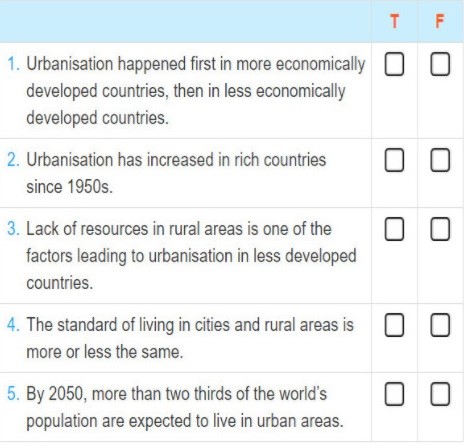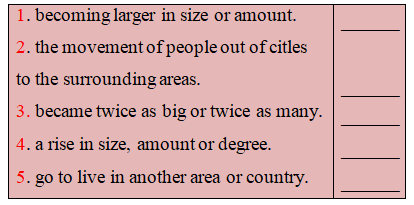Unit 2 lớp 12: Urbanisation-Reading
Bài học Unit 2 Lớp 12 mới phần Reading hướng dẫn các học tìm hiểu bài đọc về vấn đề Đô thị hoá hiện nay thông qua một số dạng bài tập đọc hiểu trả lời câu hỏi, chọn đáp án đúng sai.
Mục lục nội dung

1. Task 1 Unit 2 lớp 12 Reading
You are going to read a text about urbanisation. Predict whether the following statements are true (T) or false (F) (Bạn sẽ đọc một văn bản về đô thị hóa. Dự đoán các nhận định sau đây là đúng (T) hoặc sai (F))
Guide to answer
1. T; 2. F; 3. T; 4. F; 5. T
Tạm dịch
1. Đô thị hóa đã xảy ra lần đầu tiên ở các nước kinh tế phát triển, sau đó ở các nước kém phát triển về kinh tế. ⇒ T
2. Đô thị hóa đã gia tăng ở các nước giàu có từ những năm 1950. ⇒ F
3. Thiếu nguồn lực ở các khu vực nông thôn là một trong những yếu tố dẫn đến đô thị hóa ở các nước kém phát triển hơn. ⇒ T
4. Mức sống ở các thành phố và các khu vực nông thôn ít nhiều giống nhau. ⇒ F
5. Đến năm 2050, hơn hai phần ba dân số thế giới sẽ sống ở các khu vực đô thị. ⇒ T
2. Task 2 Unit 2 lớp 12 Reading
Read the text and check your predictions in 1 (Đọc văn bản để kiểm tra những dự đoán trong phần 1)
Urbanisation is the process by which urban areas grow bigger as more and more people leave the countryside to live in towns and cities
Before the 1950s, urbanisation mainly occurred in more economically developed countries (MEDCs). Rapid urbanisation happened during the period of industrialisation in Europe and North America in the nineteenth and early twentieth centuries. A lot of people left their home villages for urban areas hoping to find jobs in the rapidly expanding industries in big towns and cities. Since 1950s urbanisation has become slower in most MEDCs. Now, some of the biggest cities are losing population because people go back to live in rural areas. This is known as counter-urbanisation
Since 1950, urbanisation has grown rapidly in LEDCs (Less Economically Developed Countries) in Africa and South America. Between 1950 and 1990 while the urban population in LEDCs doubled, increase was less than half in developed countries
There are various causes of urbanisation in LEDCs. Here are some major ones. First, people migrate to urban areas on a massive scale due to lack of resources in rural areas. Second, small farmers find it h to make a living not just because of bad weather conditions such as drought, floods, or storms, because they can't compete with large agricultural companies. These are considered ‘push’ factors
People living in rural areas are also ‘pulled’ to cities, which are known to be places of financial centres, services, wealth and opportunities. Believing that standard of living in urban areas will be higher in rural areas, many people come to the city seeking their fortune
Today, about half of the world's population in urban areas. Urbanisation has provided opportunities, higher incomes and better access to health facilities and education. The urban population will continue to grow and it is expected that proportion will increase to 70% by 2050
Tạm dịch
Đô thị hóa là quá trình trong đó khu vực đô thị phát triển rộng lớn hơn khi mà ngày càng nhiều người dân rời khỏi vùng nông thôn đến sống ở các thị trấn và thành phố
Trước những năm 1950, đô thị hóa chủ yếu xảy ra ở nhiều quốc gia phát triển về kinh tế (MEDCs). đô thị hóa nhanh chóng xảy ra trong thời kỳ công nghiệp ở châu Âu và Bắc Mỹ trong thế kỷ XIX và đầu XX. Rất nhiều người rời quê hương của họ đến với khu vực đô thị hy vọng tìm được việc làm trong các ngành công nghiệp phát triển ở các thị trấn và thành phố lớn. Kể từ năm 1950 đô thị hóa đã trở nên chậm hơn trong hầu hết các MEDCs. Bây giờ, một số thành phố lớn đang giảm dân số vì họ trở lại sống ở khu vực nông thôn. Điều này được gọi là phản đô thị hóa
Kể từ năm 1950, đô thị hóa đã phát triển nhanh chóng trong LEDCs (Quốc gia kém phát triển hơn về kinh tế) ở châu Phi và Nam Mỹ. Giữa năm 1950 và 1990 trong khi dân số đô thị ở LEDCs gấp đôi, trong khi các nước phát triển lại tăng ít hơn một nửa
Có nhiều nguyên nhân khác nhau của đô thị hóa ở LEDCs. Dưới đây là một số nguyên nhân lớn. Đầu tiên, người di chuyển đến các khu vực đô thị trên quy mô lớn do thiếu nguồn lực ở các khu vực nông thôn. Thứ hai, nông dân cảm thấy khó khăn hơn để kiếm sống không chỉ thời tiết xấu như hạn hán, lũ lụt, bão, mà còn bởi vì họ không thể cạnh tranh với các công ty nông nghiệp lớn. Đây được coi là yếu tố 'đẩy'
Người dân sống ở khu vực nông thôn cũng được 'đẩy' tới các thành phố, được biết đến là trung tâm dịch vụ tài chính, tài sản và cơ hội. Tin tưởng rằng mức sống ở các khu vực đô thị sẽ cao hơn ở nông thôn, nhiều người đến với thành phố tìm kiếm vận may của họ
Ngày nay, khoảng một nửa dân số thế giới trong khu vực đô thị. Đô thị hóa đã cung cấp những cơ hội, thu nhập cao hơn và tiếp cận tốt hơn tới cơ sở y tế và giáo dục. Dân số đô thị sẽ tiếp tục phát triển và dự kiến tỷ lệ đó sẽ tăng lên 70% vào năm 2050
3. Task 3 Unit 2 lớp 12 Reading
Find the words in the text that have the following meanings. Write the words in the space provided (Tìm các từ trong văn bản có ý nghĩa như sau. Ghi các từ vào chỗ trống được cung cấp)
Guide to answer
1. expanding
2. counter-urbanisation
3. doubled
4. increase
5. migrate
Tạm dịch
1. Mở rộng: trở nên lớn hơn về kích thước hoặc lượng
2. Liên đô thị hóa: di chuyển của người dân ra khỏi thành phố đến các khu vực lân cận
3. Gấp đôi: trở nên gấp đôi
4. Sự tăng lên: sự gia tăng kích thước, số lượng hoặc mức độ
5. Di cư: đi đến sống trong khu vực hoặc quốc gia khác
4. Task 4 Unit 2 lớp 12 Reading
Read the text carefully. Answer the following questions (Đọc văn bản một cách cẩn thận. Trả lời các câu hỏi sau đây)
1. What is urbanisation? (Đô thị hóa là gì?)
2. What do MEDCs and LEDCs stand for? (MEDCs và LEDCs là viết tắt của từ gì?)
3. Where did rapid urbanisation take place prior to 1950? Why? (Trước năm 1950, đô thị hóa diễn ra ở đâu? Vì sao?)
4. What happened after 1950? (Chuyện gì xảy ra sau năm 1950?)
5. What are some of the 'push' factors of urbanisation? (Một số yếu tố "thúc đẩy" đô thị hóa là gì?)
6. Why are small farmers' lives difficult? (Tại sao cuộc sống của người nông dân gặp khó khăn?)
7. What are some of the ‘pull’ factors of urbanisation? (Một số yếu tố "kéo theo" của đô thị hóa là gì?)
Guide to answer
1. It's a process by which urban areas grow bigger as more and more people leave the countryside to live in towns and cities (Đó là một quá trình mà các khu vực đô thị ngày càng nhiều người từ khu vực nông thôn chuyển tới sống trong thị trấn hoặc thành phố)
2. MEDCs stands for more economically developed countries. LEDCs stands for less economically developed countries (MEDCs là viết tắt của nhiều nước kinh tế phát triển. LEDCs là viết tắt của các nước kinh tế kém phát triển)
3. Before the 1950s, rapid urbanisation took place in Europe and North America because it was the period of industrialisation in these areas (Trước năm 1950, đô thị hóa nhanh chóng diễn ra ở Châu Âu và Bắc Mỹ vì đây là giai đoạn công nghiệp hóa khu vực này)
4. After 1950, urbanisation started to grow rapidly in LEDCs (Sau năm 1950, đô thị hóa bắt đầu phát triển nhanh chóng ở các nước kém phát triển)
5. Some of the ‘push’ factors of urbanisation are lack of resources in rural areas, bad weather conditions, and competition from large agricultural companies. (Một số yếu tố thúc đẩy đô thị hóa phát triển là thiếu các nguồn lực ở nông thôn, điều kiện thời tiết xấu và cạnh tranh từ các công ty nông nghiệp lớn)
6. Because they have to suffer bad weather conditions and competition from large agricultural companies (Bởi vì họ phải chịu đựng điều kiện thời tiết xấu và cạnh tranh từ các công ty nông nghiệp lớn)
7. Some of the ‘pull’ factors of urbanisation are the centralisation of resources such as money, services, wealth and opportunities as well as the higher living standards of these areas (Một số yếu tố kéo theo của đô thị hóa là tập trung các nguồn lực như tiền, dịch vụ, sự giàu có và cơ hội cũng như mức sống cao hơn của những khu vực này)
5. Task 5 Unit 2 lớp 12 Reading
Discuss with a partner (Thảo luận với một người bạn)
How has your area been affected by urbanisation? (Khu vực của bạn đã bị ảnh hưởng như thế nào bởi đô thị hoá?)
Guide to answer
- Some problems include inadequate water and sanitation, lack of rubbish disposal, and industrial pollution
- Urbanisation has provided opportunities, higher incomes and better access to health facilities and education
Tạm dịch
- Một số vấn đề bao gồm nước và vệ sinh, thiếu cách xử lý rác thải, và ô nhiễm công nghiệp
- Đô thị hóa đã tạo cơ hội, thu nhập cao hơn và tiếp cận tốt hơn với các cơ sở ý tế và giáo dục
6. Practice
Read the passage and choose the correct answer A, B, C or D for question (Đọc đoạn văn sau và chọn phương án đúng cho các câu hỏi)
A striking feature of Viet Nam’s remarkable progress over the last few decades is the rapid pace of urbanisation. In 1986, there were fewer than there are 30 million urban residents. Today there are 30 million. Cities have become strong growth forces, with urban areas growing twice as fast as the national average rate, and contributing over half of the country’s gross domestic product. Viet Nam needs to reshape its urbanization process to create more efficient cities - cities that have sufficient population densities are well connected internally and regionally, and well managed. In addition, in line with Viet Nam's strong preference for social equity, cities will need to ensure inclusion of all residents, with no groups or area “left behind." Meanwhile, rural residents increasingly lag behind their urban counterparts in income and access to services, leading many to migrate to cities. Migration presents challenges for urban management but also opportunities to enhance labor mobility. Fortunately, these trends can be reversed. For example, four years ago, Alley 76 in Binh Thanh District, Ho Chi Minh City was only narrow enough for one motorbike to get through. Store owner Bui Thi Mai knows how a clean and efficient city can make or break a business. When it rained, the alley was often flooded with floating garbage and mosquitoes. Crime was increasing. Today, after undergoing major upgrading under an urban renewal project, the street is cleaner, safer and trucks carry goods to her door. Her family income has soared and her life has been completely changed
Question 1: Urbanisation in Viet Nam has _______
A. mainly contributed to the country’s GDP
B. promoted the country’s economy twice as fast as before
C. made rural areas develop along with urban ones
D. made urban areas develop faster than the average
Question 2: All of the following are necessary for efficient cities EXCEPT _______
A. management decision
B. sufficient working population
C. internal and regional connections
D. good organisation
Question 3: It can be inferred from the passage that along with urban migration_______
A. cities offer sufficient employment opportunities for migrants
B. population of cities accounts for the majority of the country's
C. the city authorities face both advantages and disadvantages
D. people in rural areas do not suffer from poor infrastructure in the city
Question 4: The responsibility of city authorities is _______
A. to provide equal opportunities for every group of residents
B. to stop the migration from the rural areas
C. to contribute much more to the country's gross domestic product
D. to leave all difficulties behind in order to move forward
Question 5: All of the following are benefits from the urban renewal project EXCEPT that _______
A. the streets and alleys will no longer be flooded
B. business and the living conditions have been improved
C. the neighbourhood has become cleaner and safer
D. people can have goods carried to their door
7. Conclusion
Kết thúc bài học Unit 2 Tiếng Anh mới Lớp 12 – Reading, các em cần ghi nhớ một số từ vựng sau và nắm được các thông tin cơ bản về đô thị hóa cũng như nguyên nhân của nó:
- Expand: mở rộng
- counter-urbanisation: liên đô thị hóa
- increase: tăng lên
- migrate: di cư
Tham khảo thêm
- docx Unit 2 lớp 12: Urbanisation-Getting Started
- docx Unit 2 lớp 12: Urbanisation-Language
- docx Unit 2 lớp 12: Urbanisation-Speaking
- docx Unit 2 lớp 12: Urbanisation-Listening
- docx Unit 2 lớp 12: Urbanisation-Writing
- docx Unit 2 lớp 12: Urbanisation-Communication and Culture
- docx Unit 2 lớp 12: Urbanisation-Looking Back
- docx Unit 2 lớp 12: Urbanisation-Project





